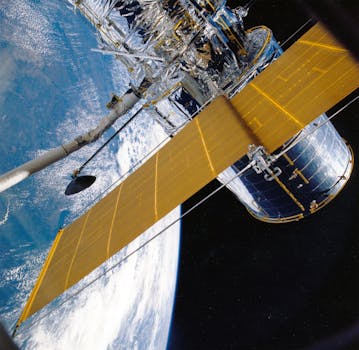From Geostationary to Low Earth Orbit: The Evolution of Satellite Telecommunications in 2023 – Satellite Telecommunications

Satellite Telecommunications has undergone significant transformations over the years, with the industry shifting from geostationary to low Earth orbit satellites. This evolution has revolutionized the way we communicate, with faster and more efficient connectivity. In this article, we will delve into the history of satellite telecommunications, the benefits of low Earth orbit satellites, and the current state of the industry.
The first commercial communications satellite, Intelsat 1, was launched in 1965 and operated in geostationary orbit. Geostationary satellites orbit the Earth at an altitude of approximately 36,000 kilometers, which allows them to remain stationary relative to a fixed point on the Earth’s surface. This made it ideal for telecommunications, as it enabled continuous connectivity between two points on the Earth. However, geostationary satellites have limitations, such as high latency and limited bandwidth.
In recent years, there has been a shift towards low Earth orbit satellites, which operate at an altitude of around 160 to 2,000 kilometers. Low Earth orbit satellites have several advantages over geostationary satellites, including lower latency, higher bandwidth, and improved connectivity. One of the key benefits of low Earth orbit satellites is their ability to provide global coverage, including remote and underserved areas. Companies such as SpaceX, OneWeb, and Amazon’s Kuiper Systems are leading the charge in developing low Earth orbit satellite constellations.
The development of low Earth orbit satellites has also led to advancements in satellite technology. New technologies such as phased arrays, digital beamforming, and advanced propulsion systems have improved the efficiency and capabilities of satellites. Additionally, the use of 3D printing and other manufacturing techniques has reduced the cost and time required to build satellites. The satellite industry is also experiencing a shift towards software-defined satellites, which enable greater flexibility and reconfigurability.
In conclusion, the evolution of satellite telecommunications has transformed the way we communicate, with a shift from geostationary to low Earth orbit satellites. The benefits of low Earth orbit satellites, including lower latency, higher bandwidth, and improved connectivity, have made them an attractive option for telecommunications companies. As the satellite industry continues to evolve, we can expect to see further advancements in satellite technology and the development of new applications and services.
The impact of satellite telecommunications on the telecommunications industry cannot be overstated. Satellite telecommunications has enabled global connectivity, facilitating communication between people and businesses around the world. The development of low Earth orbit satellites has also created new opportunities for telecommunications companies, such as providing broadband services to remote and underserved areas. Furthermore, satellite telecommunications has played a critical role in supporting disaster recovery and humanitarian efforts, providing critical connectivity in areas where traditional infrastructure has been damaged or destroyed.



